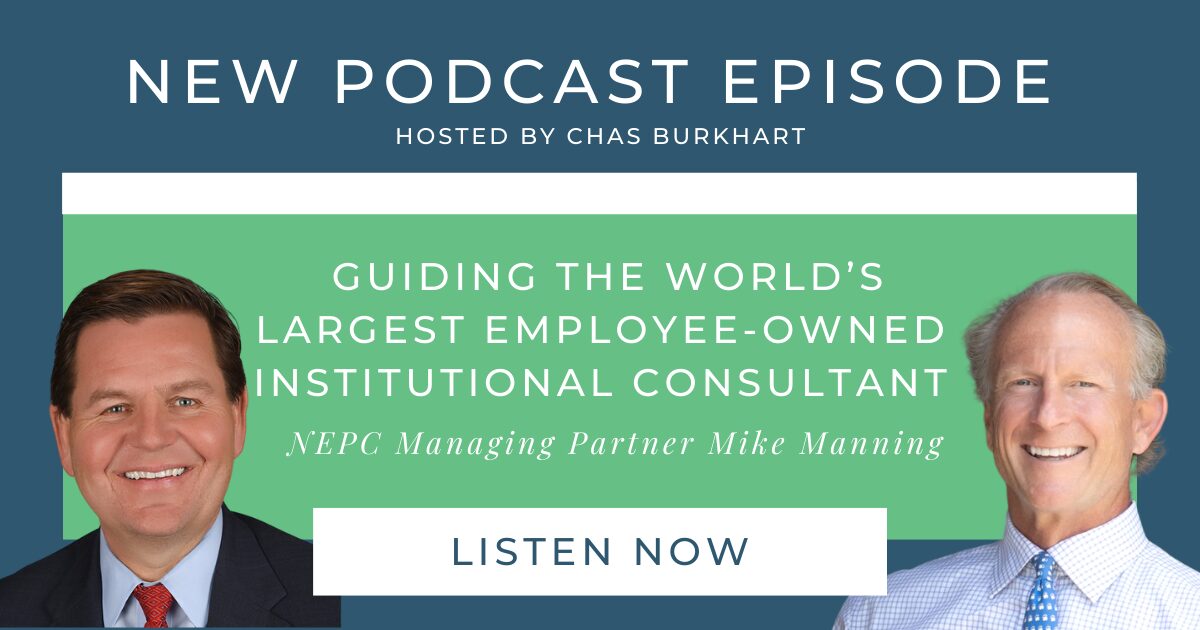Family Wealth Report: Setting The Scales On AI: Rebalancing Risk, Staying Open To Opportunities
NEPC’s Karen Harding recently guest authored an article for Family Wealth Report, exploring how wealth management firms can thoughtfully navigate the evolving landscape of artificial intelligence — balancing emerging risks with strategic opportunities. View the article on Family Wealth Report’s site here.
How should wealth managers and others allocating assets think about how to play artificial intelligence? To try to answer that question is Karen Harding, who is partner at Boston-headquartered investment company NEPC. She is also the team leader of NEPC’s private wealth practice group. (More about the author below.)
The editors are pleased to share these insights. We don’t necessarily endorse all views of guest writers and urge readers to respond with their views. Please get involved in the conversation, so email [email protected] and [email protected]
In recent years, the stock market has witnessed an unprecedented concentration of capital in a select group of technology giants, often referred to as the “Magnificent 7”: Apple, Microsoft, Amazon, Alphabet (Google), Meta Platforms, Tesla, and Nvidia. These firms have been leading the charge in developing and deploying artificial intelligence (AI), predicted to be an essential technology for future business competitiveness.
But the success of the Mag 7 has created a conundrum for wealth management advisors. Maintaining a market level of exposure to these stocks requires significant portfolio concentration; rebalancing away from them may lower portfolio risk, but potentially at the cost of tracking market results. How can advisors ensure that their clients are properly exposed to the potential of AI without taking on too much concentration risk?
As we have explored this issue with our clients at NEPC, we have come to believe that the answer lies less in derisking client portfolios, and more in identifying the right risks to take, given the client’s investment guidelines.
Historic concentration
As of December 31, 2024, Mag 7 accounted for more than a third of the market cap for the entire S&P 500, according to data from Yahoo!. That’s up from 19 per cent only five years ago, in 2019. Stock markets haven’t seen this level of concentration since the Nifty 50 trend of the 1970s.
Exposure to these technology leaders has produced excellent results for investors, but it has also imposed considerable volatility risk. Mag 7’s contribution to the S&P 500’s monthly volatility has risen in tandem with their market cap share, accounting for more than 40 per cent of total S&P volatility by mid-2023.
No matter how innovative or valuable the Mag 7s are, portfolios that are heavily exposed to them take on a wide range of company-specific risks, such as regulatory challenges, management missteps, supply chain disruptions, to name just a few. In addition, investors broadly do not support ultra-high valuations during periods of market or economic instability. Diversification, achieved through regular rebalancing, is the best defense against these risks.
Strategic reallocation
As long as the Mag 7 continue their performance run, advisors will need to be strategic when attempting to rebalance portfolios that are heavily exposed to them. Approaches that reinvest Mag 7 gains into historically lower volatility sectors will dramatically derisk the portfolio – potentially by too much.
In our experience, smart rebalancing doesn’t necessitate exiting the technology sector entirely. Investors can reallocate proceeds to maintain tech exposure while broadening their opportunity set. For example, AI and related trends are expected to create a more favorable environment for select semiconductor firms and chip manufacturers.
Other sectors stand to gain from the adoption of AI and related technologies. The energy sector is experiencing increased demand due to the high energy consumption of data centers powering AI applications. Similarly, the biotechnology sector is leveraging AI for improved diagnostic tools and personalized medicine.
Sectors such as these present alternate opportunities for capitalizing on AI technology – and smart ways to find the right risks in a more diversified portfolio.
AI is not the only trend that offers investors opportunity. Industrials and infrastructure stocks are expected to benefit from government spending and the rehoming of manufacturing capacity to the United States, in addition to improving robotics. And, given recent stock market volatility, don’t forget the value of having cash reserves.
Cash on hand provides dry powder that enables investors to capitalize on price declines in the market. Such opportunistic investments can enhance long-term returns while improving diversification and managing risk.
Guidelines for rebalancing
No matter how unique or unprecedented the market environment is, it’s always beneficial to reiterate why rebalancing is so important. Helping clients stay aligned with their risk tolerance is often the most valuable role wealth managers play: as the adage goes, you make wealth through concentration, but you keep wealth through diversification. The best practices for rebalancing haven’t changed:
- Consistency and discipline: Rebalancing should be conducted regularly and systematically, adhering to a predetermined schedule rather than being triggered by short-term market fluctuations;
- Alignment with asset allocation and risk tolerance: Adjustments should keep the portfolio in line with client’s financial objectives and risk appetite; and
- Tax considerations: Be mindful that selling appreciated assets may trigger capital gains taxes, so it is essential to incorporate those costs into your strategy. Rebalancing is not about eliminating risk but about taking the right risks given client needs and the characteristics of the current market environment. By thoughtfully adjusting portfolio allocations, investors can manage exposure to concentrated positions, enhance diversification, and position themselves to take advantage of emerging opportunities, regardless of market movements.
About the author
Karen Harding brings over 25 years of industry experience and is experienced across all facets of wealth management. Prior to joining NEPC in 2017, she served as managing director and co-head of the investment advisory services team for CTC | myCFO. Harding is also a member of NEPC’s Partners Research Committee and currently serves on the investment committee of the Oregon Community Foundation.
Barron's PENTA: How to Invest as the Fed Starts to Ease up on the Accelerator
NEPC’s Karen Harding was quoted in a recent Barron’s PENTA article which was an in-depth guide for how ultra-high net worth individuals should be thinking about allocations and working with their advisors to navigate this economic environment. View the article on the PENTA site here.
Investors have spent the past 18 months watching as the U.S. central bank hiked interest rates from a pandemic low of between 0.25% and 0.50%, all the way up to 5.5%.
Now, with just one Federal Reserve policy meeting left in the year, the best strategy might be a proactive one: trying to get ahead of what the central bank does in 2024, according to Karen Harding, team leader for the private wealth practice group at Boston-based NEPC.
“What’s important for investors to keep in mind is that we’re probably at the peak of the tightening cycle,” Harding says.
. . .
The past two years have been a bloodbath for bonds, as markets reacted to higher rates, and to policymakers’ insistence that rates may remain higher for longer than many investors expect. “When you’re in a rate-cutting cycle, bond prices go up,” Harding says. “So, just as bond investors have seen losses in their portfolios, they will get gains now.”
. . .
Financial advisors to wealthy clients should have, or be able to tap, expertise on the kind of credit research needed to pick individual bonds for a portfolio or a ladder, Harding says. “It really does benefit most investors to have a professional invest for them.” Those who don’t have quite as much to invest still might be able to get similar exposure from an exchange-traded fund or mutual fund.
Still, there’s good reason for investors, especially squeamish ones, to simply sit on the sidelines for a bit. “You can get more on a cash yield [basis] than you can holding a fixed income instrument because the yield curve is still inverted,” Harding says. That is, shorter-term rates are higher than longer ones. That’s traditionally been a sign that investors are expecting an economic downturn relatively soon.
U.S. News & World Report: How Financial Advisors Work With Billionaires
NEPC’s Karen Harding was quoted in a recent U.S. News & World Report article to provide insight into how advisors work with ultra-high-net-worth clients to preserve generational wealth. View the article on U.S. News’ site here.
Managing a billionaire’s finances may entail intricate financial instruments, such as trusts, foundations, and investments in various industries and asset classes. In addition, tax optimization and estate planning become paramount to preserving wealth across generations.
While allocating into a balanced portfolio of cost-effective exchange-traded funds is frequently a winning strategy for mass affluent clients, that’s usually not enough for a billionaire’s assets.
. . .
“A trusted advisor will work alongside clients to help create and execute a customized portfolio based on their client’s needs and objectives,” says Karen Harding, a partner in the private wealth practice at Boston-based NEPC.
The factors a billionaire’s advisor considers include goals and objectives, risk tolerance, tax status, cash flow needs and entity structure in order to build an appropriate portfolio, Harding says. Here are some of the criteria billionaires use when selecting financial advisors to handle their wealth:
. . .
“With over three decades of experience working with ultra-high-net-worth clients, we often see a focus on maintaining multi-generational wealth,” Harding says.
“One consideration to keep in mind is that clients often still own the operating business which created their family’s wealth,” Harding adds. “If this is the case, the investment portfolio needs to take the operating business into consideration when decisions are being made for the investment portfolio.”
. . .
Harding says billionaires seek advisors with whom they have a strong alignment and no conflicts of interest.
“They tend to work with advisors who have the deep resources required to successfully execute their desired plan, who have the technical skills required to create and implement a sophisticated portfolio,” she says.
Click here to continue reading the full U.S. News & World Report article.
U.S. News & World Report: How to Find a High-Net-Worth Financial Advisor
NEPC’s Karen Harding was quoted in a recent U.S. News & World Report article to provide insight into factors high-net-worth investors should consider when seeking services beyond asset management. View the article on U.S. News’ site here.
When it comes to selecting a financial advisor, wealthier investors often need a different level of service, when compared to what’s called the “mass affluent.”
An investor with assets between $100,000 and $1 million is generally considered mass affluent, but the definition of high net worth varies. Some advisors consider a high-net-worth client to have over $1 million in assets; others use a $10 million threshold.
Choosing a financial advisor can be challenging for high-net-worth investors for a few reasons. Because they have more complex financial needs, high-net-worth clients need an advisor, or team of advisors, with specialized skills. Keep the following tips in mind as you select the best advisor for your needs:
. . .
Karen Harding, a partner in the private wealth practice group at NEPC in Boston, MA, says services high-net-worth clients should consider, in addition to asset management, include financial and estate planning, tax strategy, financial reporting, philanthropic advisory services, property management, household management, aviation management, and financial education and assistance for family members.
“While most firms do not offer all of these services, they are able to outsource to other firms to ensure that the client has their needs met,” she says.
. . .
Harding adds that high-net-worth clients should consider whether or not an advisory firm has adequate resources and a team of professionals with the technical skills and qualifications required to do the job well.
“Make sure that an advisor has plenty of experience working with clients in similar situations and is trustworthy and personable,” she says. “Do not underestimate the importance of a good working relationship.”
Click here to continue reading the full U.S. News & World Report article.
Pensions & Investments: Market Shocks Prompt Allocation Overhauls
NEPC’s Aaron Chastain was quoted in a recent Pensions & Investments article to weigh in on how corporate pension plan portfolios in the U.K. & U.S. have been distorted by upheaval. View the article on Pensions & Investments’ site here.
Corporate pension fund portfolios in the U.K. and U.S. that have been distorted by recent market events are set for an asset allocation overhaul. A combination of rising interest rates leading to falling liabilities, plus increased needs for liquidity in portfolios means asset allocations are, in some cases, no longer serving their intended purpose on either side of the pond. Sources said pension fund sponsors now have an opportunity to further derisk portfolios, with a view to completing a risk transfer or achieving self-sufficiency.
. . .
There are also conversations among U.S. plans on what constitutes an appropriate interest rate hedge, since it “now takes less dollars to achieve the same interest rate hedge,” said Aaron Chastain, Atlanta-based senior consultant at NEPC LLC.
. . .
NEPC’s Mr. Chastain is also seeing some clients reducing commitment sizes but not stopping investments altogether. They “definitely don’t want to eliminate those relationships (with fund managers) for a shorter-term market event in terms of an asset allocation perspective,” he said.
Click here to continue reading the full Pensions & Investments article.
Bloomberg: Stocks See Late-Day Rebound After Unnerving Twists: Markets Wrap
NEPC’s Phill Nelson was quoted in a recent Bloomberg article to discuss what to expect from the 9/21/22 Fed meeting’s announcement on interest rates. View the article on Bloomberg’s site here.
Stocks pushed higher in the final hour of New York trading, with a rally in megacaps like Apple Inc. and Tesla Inc. driving a rebound that followed the worst weekly rout for the market since mid-June.
Major equity benchmarks had a tough time finding direction Monday as traders geared for another super-sized US rate increase amid fears on whether the Federal Reserve could overtighten and raise the odds of a hard landing. Treasury 10-year yields hovered near 3.5% while the two-year rate, which is more sensitive to imminent policy moves, hit the highest since 2007.
. . .
“The question to focus on isn’t whether the Fed will hike rates by 75 basis points or 100 basis points,” said Phillip Nelson, head of asset allocation at NEPC. “What we’re looking for is how aggressive Powell will be in the next six to 12 months. The messaging we get in the next few weeks could be a bigger data point and a shock to investors.”
Pensions & Investments: ESG: Multi-Asset Investing
NEPC’s Dulari Pancholi was featured in a recent Pensions & Investments article to share top ESG themes as well as developments in data, benchmarks and regulation that are powering continued inflows into ESG investing across both public and private assets. View the article on Pensions & Investments’ site here.
Environmental, social and governance investing has evolved far beyond a process based on exclusion to one that is inclusive, activist and focused on alpha. Institutional investors are addressing the dual purpose — to effect change and generate alpha — via a range of sustainable investment approaches, typically impact funds, asset-specific ESG strategies or multi-asset portfolios.
Across all approaches, the state of investing based on ESG factors is robust. Global ESG assets under management were $35.3 trillion in 2020, up 15% from $30.6 trillion in 2018, according to the Global Sustainable Investment Alliance. ESG’s portion of total global AUM rose to 35.9% from 33.4% in the same period.
GSIA projects global ESG AUM will rise 16%, to $41 trillion, this year; and 22%, to $50 trillion, by 2025. The message is clear: ESG investing is here to stay, and its future is bright
. . .
While a multi-asset strategy can be one of several ways to implement an ESG investment approach, Dulari Pancholi, CFA, CAIA, principal and head of credit and multi-asset at NEPC, said that she sees multi-asset as the right approach for asset owners today.
“The way ESG investing has evolved almost requires you to take a multi-asset approach,” she said. “The investible universe has expanded so much beyond the listed stocks where ESG originated. Now there are asset classes like private debt and private markets, or debt more generally, [and they] are tougher to work with” in terms of the availability of ESG products and challenges in ESG data collection. “In the fixed-income space, for example, you now have green bonds, which are an evolution of green revolving-loan facilities. There are term loans that are tied to sustainability metrics and sustainability-linked bonds that are tied to the ESG performance of the portfolio or underlying company.
“So if you’re trying to build an ESG portfolio that can integrate some or all of the available asset classes, you need a toolbox that can hold a lot of different tools. That’s what multi-asset is all about,” Pancholi said.
Click here to continue reading the full Pensions & Investments article.
The Wall Street Journal: Almost Half of Stock Pickers Beat the Market in Early 2022 Selloff
NEPC’s Tim McCusker was quoted in a recent Wall Street Journal article to discuss how active managers have benefitted from monetary tightening in early 2022. View the article on The Wall Street Journal’s site here.
Nearly half of large-cap U.S. stock-picking funds beat the S&P 500 during the brutal selloff in the first half of the year, putting active managers on pace for their best year since 2009.
Bruised by sky-high inflation and rising interest rates, the S&P 500 fell 20% on a total return basis, which includes dividends as well as price changes, in the first six months of 2022. That was the index’s worst first half in data going back to 1988, according to Dow Jones Market Data.
. . .
“In the first half, active managers being compared against the market may have benefited from the environment of monetary tightening as the Federal Reserve began raising interest rates”, said Tim McCusker, chief investment officer at investment consulting firm NEPC.
“That’s a helpful thing for active managers,” he said. “Instead of money just flooding into equity markets and pushing all assets higher, you’re starting to see some differentiation.”
Click here to continue reading the full Wall Street Journal article.
Global Investment Leaders: Mike Manning on Guiding the World's Largest Employee-Owned Institutional Consultant
NEPC Managing Partner Mike Manning joined Rosemont CEO Chas Burkhart on the latest episode of the Global Investment Leaders podcast to share his perspective on the firm’s evolution since its founding in 1986, how NEPC is positioning for the future, and more.
Listen now:









